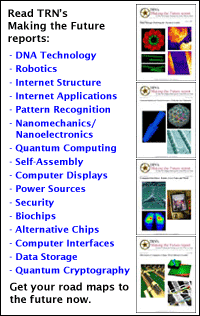
Five photons linked
By
Eric Smalley,
Technology Research NewsQuantum computers, which use attributes of quantum particles like atoms and photons to represent data, promise to solve certain very large problems many orders of magnitude faster than is possible using today's computers. The challenge is being able to manipulate particles well enough to carry out computing.
A key step is being able to entangle five particles, which would make it possible to check computations for errors and teleport quantum information within and between computers.
Researchers from the University of Science and Technology of China, the University of Innsbruck in Austria, and the University of Heidelberg in Germany have entangled five photons. "Our experiment demonstrated for the first time the ability to manipulate five-particle entanglement," said Jianwei Pan, a physics professor at the University of Science and Technology of China and a fellow at the University of Heidelberg in Germany.
Error correction uses mathematical codes to detect when a bit has been accidentally flipped, and is widely used in classical computing because electronic and magnetic bits occasionally switch accidentally from a 1 to a 0 or vice versa. Quantum bits are more delicate and require an error correction method to be feasible.
Quantum computers have the potential to be blazingly fast because a string of quantum bits, or qubits, that store the ones and zeros of computer information can represent all the numbers possible within that string at once. This would make it possible for a quantum computer to check every potential answer to a problem with a single set of operations.
Qubits take advantage of the quantum phenomenon of superposition. A photon can be polarized in one of two orientations, but when it is in superposition it is in a mix of both orientations at once.
The challenge in building computers to take advantage of the phenomenon is that superposition is a fragile condition, and interactions with the environment can knock a particle out of superposition and into one definite state. Interactions with the environment can also have more subtle effects that can result in the equivalent of a qubit being flipped from a 1 to a 0 or vice versa.
Researchers have devised many quantum error correction codes that can correct these errors and restore a qubit to its proper superposition state. But these codes require entangling multiple particles. Properties of particles that are entangled remain in lockstep regardless of the distance between the particles.
The simplest code calls for entangling three qubits, but requires repeating the process twice using two additional sets of three qubits. The one-step code requiring the fewest entangled qubits uses five. "Five-particle entanglement... is the threshold number of qubits required for universal error correction," said Pan.
The researchers also used the five-photon entanglement process to carry out open-destination teleportation, which could be used for distributed quantum computing.
Quantum teleportation is akin to faxing a document and in the process destroying the original. Teleportation is a potential method of transferring information within quantum computers, and can also eventually be used to transport information among quantum networks.
Teleportation involves using a pair of entangled particles to transmit the quantum state of a third particle. The entangled pair is split between the sender and receiver and the third particle is teleported to the receiver when the sender brings it into contact with his half of the pair. This transfers the quantum information of the third particle to the sender's particle, in the process destroying the original. The sender measures his particle and then tells the receiver how he made the measurement. The receiver makes the same measurement on his half of the pair, which converts it into a copy of the third particle.
Open-destination teleportation uses three or more entangled particles to teleport the attributes of a single particle onto several other particles, said Pan. "In our experiment, an unknown quantum state of a single particle is first teleported onto a three-particle superposition," said Pan. "At a later stage, this teleported state can be read out at any of the three particles," said Pan.
Open-destination teleportation makes it possible to transmit quantum information to any one of several processors within a quantum computer or nodes in a quantum network. "One can... choose which particle should act as the output," said Pan.
Researchers were able to entangle four quantum particles for the first time seven years ago, said Pan. It will be more than ten years before the technology can be used practically, he said.
Researchers generally agree that full-scale quantum computers are one or two decades away. Full-scale quantum computers would render most of today's encryption technologies obsolete.
Pan's research colleagues were Zhi Zhao, Yu-Ao Chen, An-Ning Zhang and Tao Yang of the University of Science and Technology of China, and Hans J. Briegal of the Australian Academy of Sciences. The work appeared in the July 1, 2004 issue of Nature. The research was funded by the National Natural Science Foundation of China, the Chinese Academy of Sciences, the Chinese National Fundamental Research Program, and the German Research Foundation (DFG).
Timeline: > 10 years
Funding: Government
TRN Categories: Quantum Computing and Communications; Physics
Story Type: News
Related Elements: Technical paper, "Experimental Demonstration of five-Photon Entanglement and Open-Destination Teleportation," Nature, July 1, 2004
Advertisements:
August 25/September 1, 2004
Page One
Selective shutdown protects nets
Tools design DNA-nanotube logic
Five photons linked
Liquid crystal IDs pathogens
Briefs:
Photosynthesis drives solar cell
Hybrid nanowire makes transistor
Nanocrystals spark efficient LEDs
Nanotubes make fluid filter
DNA copier uses little power
Method makes stronger steel
News:
Research News Roundup
Research Watch blog
Features:
View from the High Ground Q&A
How It Works
RSS Feeds:
News
Ad links:
Buy an ad link
| Advertisements:
|
 |
Ad links: Clear History
Buy an ad link
|
TRN
Newswire and Headline Feeds for Web sites
|
© Copyright Technology Research News, LLC 2000-2006. All rights reserved.